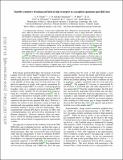| dc.contributor.author | Young, Andrea Franchini | |
| dc.contributor.author | Sanchez, Javier Daniel | |
| dc.contributor.author | Hunt, Benjamin Matthew | |
| dc.contributor.author | Choi, Sang Hyun | |
| dc.contributor.author | Watanabe, K. | |
| dc.contributor.author | Taniguchi, T. | |
| dc.contributor.author | Ashoori, Raymond | |
| dc.contributor.author | Jarillo-Herrero, Pablo | |
| dc.date.accessioned | 2014-03-20T15:14:29Z | |
| dc.date.available | 2014-03-20T15:14:29Z | |
| dc.date.issued | 2013-12 | |
| dc.identifier.issn | 0028-0836 | |
| dc.identifier.issn | 1476-4687 | |
| dc.identifier.uri | http://hdl.handle.net/1721.1/85843 | |
| dc.description.abstract | Low-dimensional electronic systems have traditionally been obtained by electrostatically confining electrons, either in heterostructures or in intrinsically nanoscale materials such as single molecules, nanowires and graphene. Recently, a new method has emerged with the recognition that symmetry-protected topological (SPT) phases1, 2, which occur in systems with an energy gap to quasiparticle excitations (such as insulators or superconductors), can host robust surface states that remain gapless as long as the relevant global symmetry remains unbroken. The nature of the charge carriers in SPT surface states is intimately tied to the symmetry of the bulk, resulting in one- and two-dimensional electronic systems with novel properties. For example, time reversal symmetry endows the massless charge carriers on the surface of a three-dimensional topological insulator with helicity, fixing the orientation of their spin relative to their momentum3, 4. Weakly breaking this symmetry generates a gap on the surface5, resulting in charge carriers with finite effective mass and exotic spin textures6. Analogous manipulations have yet to be demonstrated in two-dimensional topological insulators, where the primary example of a SPT phase is the quantum spin Hall state7, 8. Here we demonstrate experimentally that charge-neutral monolayer graphene has a quantum spin Hall state9, 10 when it is subjected to a very large magnetic field angled with respect to the graphene plane. In contrast to time-reversal-symmetric systems7, this state is protected by a symmetry of planar spin rotations that emerges as electron spins in a half-filled Landau level are polarized by the large magnetic field. The properties of the resulting helical edge states can be modulated by balancing the applied field against an intrinsic antiferromagnetic instability11, 12, 13, which tends to spontaneously break the spin-rotation symmetry. In the resulting canted antiferromagnetic state, we observe transport signatures of gapped edge states, which constitute a new kind of one-dimensional electronic system with a tunable bandgap and an associated spin texture. | en_US |
| dc.description.sponsorship | United States. Dept. of Energy (Office of Science, BES Program, contract no. FG02-08ER46514) | en_US |
| dc.description.sponsorship | Gordon and Betty Moore Foundation | en_US |
| dc.description.sponsorship | Gordon and Betty Moore Foundation (grant GBMF2931) | en_US |
| dc.description.sponsorship | United States. Dept. of Energy (Office of Science, BES Office, BES Office, Division of Materials Sciences and Engineering, under award DE-SC0001819) | en_US |
| dc.description.sponsorship | Massachusetts Institute of Technology (Pappalardo Fellowship in Physics) | en_US |
| dc.language.iso | en_US | |
| dc.publisher | Nature Publishing Group | en_US |
| dc.relation.isversionof | http://dx.doi.org/10.1038/nature12800 | en_US |
| dc.rights | Article is made available in accordance with the publisher's policy and may be subject to US copyright law. Please refer to the publisher's site for terms of use. | en_US |
| dc.source | arXiv | en_US |
| dc.title | Tunable symmetry breaking and helical edge transport in a graphene quantum spin Hall state | en_US |
| dc.type | Article | en_US |
| dc.identifier.citation | Young, A. F., J. D. Sanchez-Yamagishi, B. Hunt, S. H. Choi, K. Watanabe, T. Taniguchi, R. C. Ashoori, and P. Jarillo-Herrero. “Tunable Symmetry Breaking and Helical Edge Transport in a Graphene Quantum Spin Hall State.” Nature 505, no. 7484 (December 22, 2013): 528–532. | en_US |
| dc.contributor.department | Massachusetts Institute of Technology. Department of Physics | en_US |
| dc.contributor.mitauthor | Young, Andrea Franchini | en_US |
| dc.contributor.mitauthor | Sanchez, Javier Daniel | en_US |
| dc.contributor.mitauthor | Hunt, Benjamin Matthew | en_US |
| dc.contributor.mitauthor | Choi, Sang Hyun | en_US |
| dc.contributor.mitauthor | Ashoori, Raymond | en_US |
| dc.contributor.mitauthor | Jarillo-Herrero, Pablo | en_US |
| dc.relation.journal | Nature | en_US |
| dc.eprint.version | Original manuscript | en_US |
| dc.type.uri | http://purl.org/eprint/type/JournalArticle | en_US |
| eprint.status | http://purl.org/eprint/status/NonPeerReviewed | en_US |
| dspace.orderedauthors | Young, A. F.; Sanchez-Yamagishi, J. D.; Hunt, B.; Choi, S. H.; Watanabe, K.; Taniguchi, T.; Ashoori, R. C.; Jarillo-Herrero, P. | en_US |
| dc.identifier.orcid | https://orcid.org/0000-0001-9703-6525 | |
| dc.identifier.orcid | https://orcid.org/0000-0001-8217-8213 | |
| dc.identifier.orcid | https://orcid.org/0000-0001-5031-1673 | |
| mit.license | PUBLISHER_POLICY | en_US |
| mit.metadata.status | Complete | |
